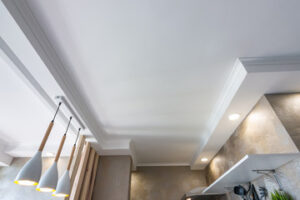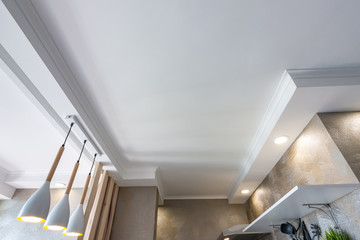Ceilings Perth are an integral part of the home, providing acoustic and thermal insulation. They also hide pipes and wires, while offering a clean aesthetic.
From coffered ceilings to vaulted roofs, they can add drama to any room. And with the right finish, they can be the focal point of your design.
Ceilings serve multiple purposes in building design, from improving acoustics and insulating a space to hiding structural elements like pipes or wiring. They also help to define the structure of a room and can be used to make a statement by being decorated or creating interesting architectural effects. In addition, ceilings help to add aesthetic appeal to a room and provide a finished look to the interior space.
There are many different types of ceilings. The most common are suspended ceilings, which consist of a grid that is suspended from the main ceiling structure and into which tiles or panels are inserted. These are often made from a variety of materials to meet specific acoustic and insulation requirements. Suspended ceilings are also easier to access than traditional ceilings for maintenance and repairs.
Another popular type of ceiling is a monolithic ceiling, which is a flat or sloping surface that is directly constructed onto the building structure. These are commonly used in industrial applications, but they can be seen in some residential spaces as well. Monolithic ceilings can be textured or painted to create an aesthetic that is either modern or historic.
In a recent study, neuroscience research showed that participants in an experiment who were shown images of rooms with various ceiling heights rated higher-ceiling rooms as more beautiful than lower-ceiling ones. Although the participants were only imagining how they would use the room, this is an indication that we have a psychological preference for high ceilings.
Healthcare environments require specialized ceilings to support infection control, acoustics and fire safety. For example, surgical rooms and other areas with immunocompromised patients must be easily cleanable to maintain hygienic standards. This may mean that ceilings must be constructed with non-porous materials that are easy to sanitize and/or have special finishes.
Acoustical ceilings are designed to reduce noise, which is particularly important in a hospital environment. They can be created from a variety of materials and can include baffles, diffusers and reflective panels to create the desired acoustics. They can also be designed to provide thermal insulation and meet fire resistance ratings.
Design
A ceiling is a unique space within a room because it provides the opportunity to add visual interest with different designs, materials, and colors. The design of a ceiling has a large impact on the overall feel of the room, influencing its ambiance, architectural style, and architectural aesthetic. From minimalist options like stretch and tray ceilings to grandiose cathedral and dome ceilings, there are ceiling styles that are perfect for every home.
Unlike the floors in your home, you cannot throw rugs up on your ceilings to add comfort and visual appeal. Rather, your choice of ceilings should be based on the overarching style of your interior. Whether your home leans towards rustic charm, contemporary chic, or classic elegance, your ceiling should be a seamless extension of that theme.
The right ceiling will create a balance between your home’s function and its ambiance, allowing you to achieve the perfect blend of warmth and sophistication. Ceilings also provide the opportunity to showcase your personal flair through intricate stencils and murals. Additionally, many ceilings are designed with fire resistance in mind to provide safety and security for your family and guests.
Ceilings are not only an integral part of a home’s design, but they also serve functional purposes such as acoustic control, thermal insulation, and hiding infrastructure. Acoustic ceilings help to absorb sound, while thermal insulation prevents heat loss or gain from the ceiling and throughout a home. In addition, ceilings can also conceal electrical wiring and plumbing for a more polished look.
In addition to enhancing the aesthetic appeal of your home, ceilings can also boost its resale value. Unique ceiling designs and accents that are carefully incorporated into the rest of your home can make it stand out among the competition and attract buyers. For example, a vaulted ceiling with equal sloping sides that reach to a narrow point is reminiscent of Gothic architecture and can make any room feel grandiose. On the other hand, a cove ceiling offers a rounded transition to your home and can give it a more elegant feel.
Materials
Ceilings play a crucial role in shaping a room’s ambiance and architectural style. They also serve a functional purpose by concealing plumbing and electrical wiring, which contributes to safety and energy efficiency. Several types of ceilings are available, each with unique characteristics and designs to suit different tastes. These include plaster, drywall, wood, and metal. Choosing the right material for your ceiling can make your home feel cozy, elegant, or modern.
Many designers and builders use metal ceilings to enhance a building’s aesthetic appeal while providing practical advantages such as fire resistance, thermal insulation, and acoustic control. These ceilings are often used in commercial buildings, schools, hospitals, and retail stores.
They are crafted from different metal materials including aluminum, galvanized iron, and steel. These metals are durable and can resist the corrosion caused by moisture or water. They are also lightweight, which reduces installation costs and the load on structural supports. They can be fabricated into curved or straight shapes and come in a variety of finishes and textures.
Metal ceilings are usually suspended from a concealed grid system that is attached with a hidden clip or spring tee, allowing them to be easily installed and removed. They are also available with reveal edge detail that exposes the suspension in a decorative fashion, while maintaining accessibility to the plenum.
Another popular ceiling option is to have artwork printed directly onto it. This is possible through a special technology that uses a canvas or membrane to create a digital image. It’s a great alternative to painting or wallpaper, and it can create a unique look for any space.
The global metal ceiling market is dominated by large, well-established players. These companies focus on research and development to improve their product offerings and stay ahead of the competition. They also offer competitive pricing to attract customers. Some of them are expanding their manufacturing facilities to meet rising demand.
Other than these, there are a number of emerging players in the market that are focusing on innovative solutions to provide better functionality and aesthetics for customers. They are also looking at ways to increase the sustainability of their products.
Installation
Ceilings add a finishing touch to a home’s interior. They impact ambiance, architectural style, and offer numerous practical benefits such as acoustic control, fire resistance, and concealing structural components. They also regulate temperature and humidity, protect the walls and floors below, and hide wires and pipes, contributing to a cleaner, safer environment.
When building a new home, or renovating an existing one, it’s important to consider the many different types of ceilings that are available. Each has its own unique advantages and disadvantages, but they all provide a polished, finished look to the interior of a room.
Drywall ceilings are a common option in residential homes. These are usually made of gypsum plaster, which provides a good level of sound and moisture insulation. They can also be textured to further enhance aesthetics or improve air quality. The installation process includes securing the drywall panels to the ceiling joists, taping, mudding, and sanding to create a smooth surface.
Suspended ceilings are another type of ceiling that can be used in a home or commercial space. This type of ceiling is typically constructed using a grid system that includes main runners and cross tees. The main runners are attached to the ceiling joists using screw eyes, with each run being set at a right angle to the next run. The cross tees separate the tiles from each other, and are supported by hanger wire threaded through the screw eyes on the main runners.
Coved ceilings are another type of decorative ceiling that can be installed in a home. These are curved ceilings that give the room a more cozy, inviting feeling. They’re typically more expensive than other ceiling options, but they provide a unique design that will add a sense of luxury to the interior of a room.
There are a variety of options for ceiling textures, including flat, orange peel, skip trowel, knockdown, and swirled. Ceilings can be painted with any color or pattern to fit the design of a specific room, and there are many different molding styles that can be added to the edges of a ceiling to make it look more polished and finished.
